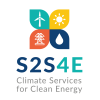Many industries are in need of reliable and usable climate forecasts for the coming weeks and months. Such predictions can help energy companies and other weather-dependent sectors better manage climate-related risks.
Renewable energy – such as wind, solar and hydropower – is the fastest growing source of electricity globally. Renewable energy comes from natural sources such as sunlight, wind, or rain, which are not continuously generated. The generation of renewable energy is thus strongly dependent on the weather, and changing weather conditions cause large variations in how much clean electricity is generated at any time.
The demand for electricity is also strongly weather-dependent, and tends to increase, for instance, when the weather gets colder and people turn on their electric heaters, and also when it gets so hot that people need air conditioning to cool down. This means that there are wide variations in both energy supply and demand, and that reliable predictions for the coming weeks and months for wind speed, temperature, precipitation, river inflows etc. would be very useful for energy companies to manage their renewable power plants more efficiently, and for strategic planning.
Forecasts for up to seven months ahead
Compared to forecasts for up to ten days ahead, which is what most people are used to seeing on the news and think about as long-term forecasts, climatic information from sub-seasonal to seasonal time-scales contain forecasts for up to six weeks and seven months ahead, respectively. Such forecasts could be of great value for a wide range of users who are affected by variability in climate, water and energy, and who would benefit from understanding and better managing climate-related risks.

Applications of forecasts at different time scales [source: Soret et al., (2019). Sub-seasonal to seasonal climate predictions for wind energy forecasting, J. Phys.: Conf. Ser.,1222, doi: 10.1088/1742-6596/1222/1/012009].
Decision Support Tool for the energy industry
Partners from the S2S4E project, which is funded by the EU’s research and innovation programme Horizon 2020, have developed the very first Decision Support Tool (DST), which provides scientifically sound, operational climate forecasts for weather-dependent solar, wind and hydropower production.
The DST is co-developed by the researchers and energy companies involved in the project, and this will also be key for the market uptake of the tool. Co-development of the DST has been achieved by understanding users’ decision-making processes, and identifying how climate information can be relevant to those processes. Creation of the tool thus started with a learning phase for both the scientists and the energy companies involved in the project, where they had to understand user needs and explain how and why forecasts can add value to users’ decision-making processes.
Consequently, the future users of the DST, the energy companies, had to become aware of what is feasible, and their initial discussions with the scientists involved in the project helped to align their expectations.
Energy indicators
The current version of the tool includes a number of different variables and indicators, such as essential climate variables, wind energy, solar energy, hydropower and energy balance. Users of the tool also have the option to see past forecasts and download the forecast data.
The tool features metadata which provides explanations about the forecasts, and this helps to narrow the communication gap between the providers of the tool and its users. The tool also features forecast skill information for each variable/indicator, and this allows the users to decide on their acceptable value.
The outlook within the tool shows the anomaly for each location and lead time – (from one week to three months ahead – using as reference either the seasonal norm (based on terciles) or extremes (10th and 90th percentiles) for the lead time of interest.
To avoid miscommunication of the predictions, the tool has the option to mask the locations in which forecasts have no skill – meaning the forecasts are not to be trusted – and users can also opt to get a summary of the forecasts for the location of interest.

Written by Ilias Pechlivanidis from the Swedish Meteorological and Hydrological Institute (SMHI). First published on the Hydrological Ensemble Prediction Experiment Blog on 13 May 2020 (https://hepex.inrae.fr/climate-services-help-improve-decision-making-for-weather-dependent-industries/).


